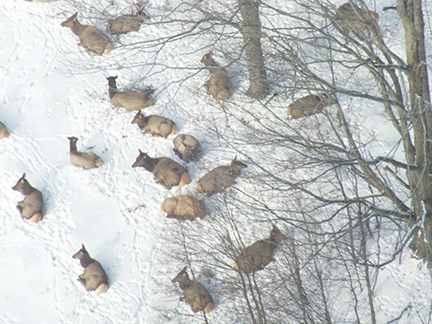Elk licenses added as animal thrives

Courtesy Photo Elk rest in snow near Gaylord in a photo taken during an aerial survey to count Michigan’s elk herd in this Michigan Department of Natural Resources photo.
ATLANTA — Twice last week, drivers in Montmorency County came to an abrupt halt when their vehicles collided with an elk.
Nobody was hurt in the crashes, according to a report from the Montmorency County Sheriff’s Office.
But the crashes illustrate that the large animal — adults can range from 500 to 800 pounds — is plentiful in Montmorency County, the heart of Michigan’s elk country. And, more than 100 years after elk were reintroduced to Michigan in 1918, the animal is thriving.
Thriving enough that, after years of elk counts remaining consistent, the Michigan Department of Natural Resources this year issued 60 more elk hunting permits than the usual 200. The additional tags may be used during the upcoming Dec. 12 to 20 hunt.
Instead of issuing a large number of elk tags to bring the population under control, the DNR decided to address higher elk numbers gradually, “trying for a soft landing,” said Brian Mastenbrook, wildlife field operations manager for the DNR.
Hunters also have a wider area in which to hunt this year after the DNR expanded hunting boundaries in hopes of controlling where elk roam.
It’s when there are too many in the wrong place that elk become a concern to humans, Mastenbrook said.
Michigan’s elk herd numbers about 900 to 1,300, based on aerial surveys. A better number would be 500 to 900, according to the DNR.
Too many elk may mean not enough food to go around. The animal can be destructive, destroying crops and wandering in front of vehicles.
Changes to the environment — such as a farmer establishing a new field or a land owner harvesting timber — can cause unwanted and potentially hazardous herd movement as curious and hungry elk investigate the changes.
Elk/vehicle collisions on I-75 recently led to the posting of elk-crossing signs along the highway as a warning to travelers, Mastenbrook said.
To make a site less appealing to elk, DNR personnel use flags, electric fences, or an elk-repellant spray.
Elk can sometimes be physically scared away by what the DNR calls “bird bangers” and “screamers” — low-level pyrotechnics that startle the elk into moving along.
“No one likes bottle rockets going off next to them,” Mastenbrook said. “With wild animals, if you make it uncomfortable for them to be there, they don’t come back.”
As a rule, elk avoid roads and people, especially during the fall deer hunting season. At this time of the year, the animals usually congregate in large numbers, often near oak trees, in search of a good crop of acorns.
During this year’s early elk hunt, over three weekends in September and October, 83 elk — 29 bulls, 52 cows and two calves — were taken, plus seven bagged by Pure Michigan or tribal hunters.
That’s a normal harvest for the early hunt, Mastenbrook said. The December hunt usually nets 140 or more elk.
In Montmorency County, Undersheriff Brian Crane said that, though the occasional motorist encounters an elk in an unfortunate moment, the animal isn’t considered a problem by county residents.
Surrounded by the animals all year, residents have human/elk cohabitation under control, he said.
“They are just another part of our community,” Crane said. “We take the good with the bad.”



